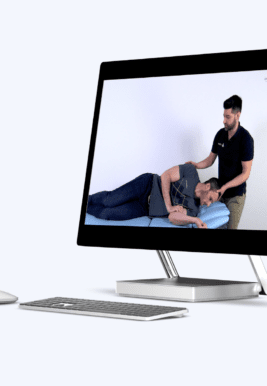Learn
Head-Neck Differentiation Test | Cervicogenic Dizziness
the premise behind neck torsion is that by holding the neck still and rotating the trunk, there is isolated stimulation of cervical afferents. Thus if the test is positive, a cervicogenic cause of the dizziness is more likely.
Trealeaven et al. (2019) performed the head-neck differentiation this test in a group of healthy subjects to determine the test’s specificity. They found a specificity of 90% in patients during the torsion part of the test. As sensitivity values first have to be evaluated in symptomatic groups, the clinical use of this test is unknown at this moment.
To perform the test, have the patient seated on a swivel chair with his eyes closed and the hip and knees flexed to 90 degrees.
Then, the examiner fixates the patient’s head in neutral position and asks the patient to actively rotate the trunk with the help of his legs to the left and right side for 45° at a metronome pace of 60 beats per minute.
This test is scored positive if the patient reports dizziness, visual disturbances, unusual eye movements after opening the eyes after the test, speech disturbance, motion sickness or nausea, slurred speech, dysphagia, light-headedness, tinnitus, headache, or paresthesia. These symptoms can occur during any of the four positions or immediately after the test.
LEARN TO TREAT THE MOST COMMON CAUSE OF VERTIGO IN THIS FREE MINI-VIDEO-SERIES

Next to the Head-Neck Differentiation Test, your dizziness exam should include the following assessments:
- Gaze stability
- Saccadic Eye Movement
- Eye-Head Coordination
- Postural Stability
- Joint Position Sense Error
- Smooth Pursuit Neck Torsion Test
- Cervical Torsion Test
Like what you’re learning?
BUY THE FULL PHYSIOTUTORS ASSESSMENT BOOK
- 600+ Pages e-Book
- Interactive Content (Direct Video Demonstration, PubMed articles)
- Statistical Values for all Special Tests from the latest research
- Available in 🇬🇧 🇩🇪 🇫🇷 🇪🇸 🇮🇹 🇵🇹 🇹🇷
- And much more!








